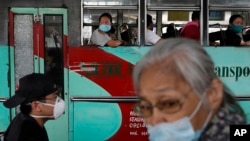The Philippine government lifted some of its strictest coronavirus containment measures Monday in what observers called a bid to salvage an economy battered by unemployment and new signs of poverty.
Most businesses were allowed to re-open and some public transportation came back to normal, per orders approved May 28 by President Rodrigo Duterte. A percentage of domestic flights started taking off again, too. Bars, dine-in restaurants and schools will remain closed while minors and the elderly are still asked to stay home.
The shutdown orders that began in mid-March have put millions out of work, threatening some with poverty that had afflicted about one in five Filipinos before the disease outbreak especially if they needed medical attention. The economy is looking at a 2.2% contraction this year, market research firm IHS Markit forecasts. Nationwide unemployment topped 10% in March and April.
Food struggled to reach consumers because farmers couldn’t move produce through locked-off parts of the country, the World Economic Forum said last month. Government food aid had missed urban slum dwellers in late March, prompting them to look for meals elsewhere, domestic news outlet Rappler reported.
Monday’s reopening moves are seen as ways to ease the economic losses in spite of a coronavirus caseload that had climbed past 18,000 as of Monday with 957 deaths and little sign of a falling caseload curve.
Reopening rules will let more shops, factories, offices and transport operators try to resume where they left off in March, said Maria Ela Atienza, political science professor at the University of the Philippines Diliman.
“There are groups, for instance the bus drivers, many of them of course lost a lot of income,” Atienza said. “Some people cannot continue working, so people definitely are desperate.”
In a Web-broadcast speech May 28, Duterte urged mall owners to give their commercial tenants rent breaks if the shops had made no money during the shutdown.
The Philippines will struggle this year especially because of the length of its shutdown orders and the halt to a normally vibrant tourism sector, said Rajiv Biswas, Asia-Pacific chief economist at IHS Markit. Poorer people face the loss of whatever little work income they might have had before the outbreak, he said.
“We don’t know how many people are dying because of the lockdown and their economic suffering,” Biswas said. “This is really an issue in poor countries, perhaps not so much in richer countries where they have some savings and the government can help them more.”
Where shutdowns persist, locals expect strict enforcement. Police and military personnel patrol some spots. In others, neighborhood heads stop residents from going too far past their houses. Beaches are closed in parts of the 109.6 million-population archipelago because they’re common gathering places.
Schools are looking toward online-only lessons later in the year or just calling off classes completely, said Rhona Canoy, president of an international school in the southern Philippine city Cagayan de Oro. She can’t pay her teachers.
“Private schools, we’re disturbed,” Canoy said. “I’m looking at options already but at the end of the day my most extreme option would be just to shut down the school and find some other business.”
Officials in relatively disease-free smaller provinces worry now that the reopening will bring an influx of people from cities with high infection rates, Atienza said. Most virus cases have been reported in Metro Manila and other major cities. “It will be more difficult now with more people going out,” she said.
Closures will ease up at varying paces from region to region, depending on local governments’ ability to manage COVID-19, the presidential office said in a statement.
“Remember that the…entire nation is still under quarantine,” Duterte was quoted saying in the statement. “Let’s see what develops ahead.”




